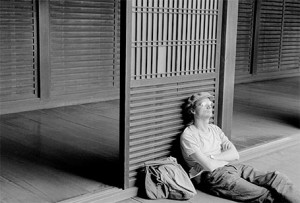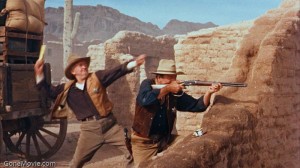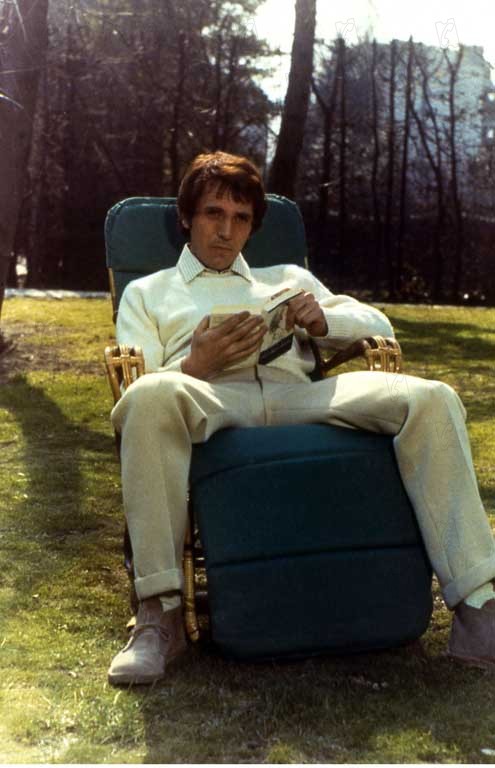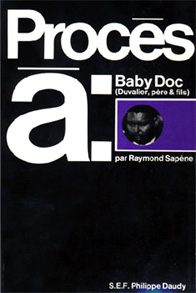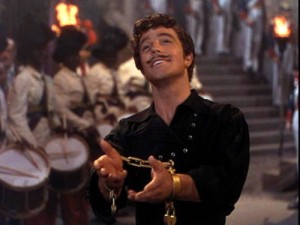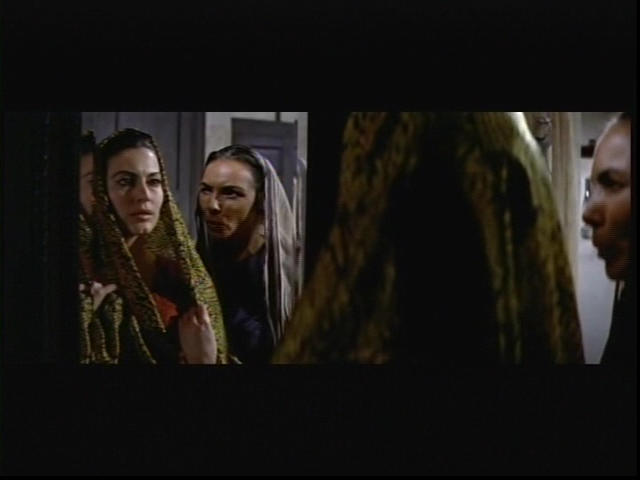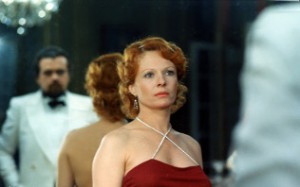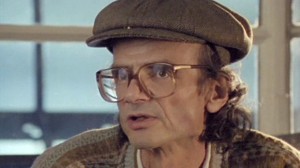From the July-August 2005 issue (NLR 34) of New Left Review.
An English translation of the first Daney collection cited below came out this year. — J.R.
We could postulate three periods for the extraordinary flourishing of film culture brought about by the French New Wave: Before, During and After. André Bazin, of course, epitomized the first, as a founding editor of the Cahiers du Cinéma in 1951, a crucial contributor to auteur theory, and champion of postwar American films and Italian neo-realism against a stale French ‘quality cinema’. The Young Turks whom Bazin nurtured at the Cahiers — Jean-Luc Godard, Jacques Rivette, Claude Chabrol, Eric Rohmer, François Truffaut, and the somewhat younger Luc Moullet — mainly defined the second period: teenage iconoclasts who picked up the camera to become the stellar practitioners of the following decades.
Serge Daney (1944–92), who started out as a disciple of the New Wave crowd and described himself as a Bazinian early on, stands as the most original commentator of the third period, which he helped to usher in and continued to redefine up until his death from aids in 1992. This stage, the Post-New Wave, was marked by an increasing preoccupation with the televisual — in combination with, as well as in contrast to, the filmic — and a broader definition of world cinema: Iran, Taiwan, India, the Maghreb and Latin America were now part of film criticism’s ‘cinema-home’. As editor of the Cahiers in the 1970s, then film critic for Libération from 1981 and founder of the eclectic Trafic in 1991, the year before his death, Daney’s turf had expanded from specialized cinephilia to the world and its history, particularly as television and cinema help us to understand it. And the fact that he considered the passage between cinema and television as a kind of physical voyage, one that could even induce jetlag, made that journey another part of his itinerary as a world traveller.
These two French volumes of his uncollected pieces, though incomplete, help us to trace some crucial aspects of the transition between Periods Two and Three. The form is roughly similar in both cases: a substantial interview with Daney (the first from 1977, the second 1983), followed by a bulky selection of film reviews, then further sections on auteurs and critical theory, reflections on actors, television, and a ‘Home and Abroad’ section (‘Ici et ailleurs’) of dispatches from film festivals around the world. The range of films reviewed is a joy. From the 18-year-old cinephile’s account of Hawks’s Rio Bravo in 1962 (‘an “a-Western”’ — the frontier ‘is not what we imagine’ — whose ‘realism answers not to a need for the picturesque but to the necessity of a psychological order’), to Pasolini’s Theorem in 1968 (as a film that ‘lays bare the process not only of its own genesis but also that of its projection, its relation to the audience . . . you and me’), to Hagman’s The Blob in 1976 (‘A gelatinous red mass that swallows everything in its path . . . one has little difficulty in recognizing Capital’) to Spielberg’s 1981 Raiders of the Lost Ark (the hard art of making cinema do the work of a comic strip: ‘to attain this strange goal requires immense labour, diabolical precision and much reflection on cinema’) to Diego Risquez’s Orinoco in 1985: a young Venezuelan’s epic history of his country, filmed in Super-8, which Daney evokes with ‘an ear still gurgling with the noise of water and a mouth tasting of yapo smoke’.
He had an inimitable flair for epigrammatic encapsulations, both of filmmakers and of philosophical positions. ‘Altman used to look at human beings with disgust’, he wrote of Popeye in 1981. ‘He found them artificial. Today he looks at an artificial character without disgust. Popeye’s difficulty in being Popeye inspires him.’ Or of the us cinema and American auteurs:
When it’s in good health, American cinema doesn’t produce auteurs but producers . . . or, more precisely, businessmen of the spectacle. Health for America is Disney, not Welles (which is why illness, in America, is so much more interesting). As entrepreneurs of the spectacle, Coppola and Lucas conduct their ventures with a mixture of megalomaniacal madness and business sense. Their madness is deployed in creating their production machines, their empires, without which there is little chance of success in fighting the studio system, Hollywood, agents, lawyers and empty professionalism.
One striking anomaly between these two volumes is their number of pages, relative to the number of years they cover. Volume 1, Le Temps des Cahiers, 1962–1981, spanning Daney’s decades as a contributor and then editor at the Cahiers, weighs in at 574 pages, which is already fairly hefty. But the volume devoted to his first five years at Libération is almost twice as big: 1,040 pages. One reason for this is the incompletion of the collection, already referred to. The excluded matter from Daney’s Cahiers period is considerable — not only many important collective pieces, but also his 265-page Procès à Baby Doc, Duvalier père et fils, a 1973 polemic against the Duvalier regime in Haiti written under the pseudonym Raymond Sapène. (And, complicating any neat divisions, some late pieces written for the Cahiers are included in the early pages of Volume 2, Les Années Libé, 1981–1985.) There is also, of course, a world of difference between editing a monthly magazine for hardcore cinephiles, which undoubtedly limited the time Daney could devote to writing, and working as a chronicler of film, tvand tennis for a daily mainstream newspaper. Nevertheless, the quantum leap in productivity after 1981 is difficult to deny, and was one of the main reasons for Daney’s increasing stature as France’s leading film critic.
The broader cultural reach of Libé enabled Daney, spurred on by examples such as Barthes and Deleuze, to speculate on a much wider canvas. He started thinking about what it means to re-see classics on tv, ranging from Griffith’s Orphans of the Storm to Minnelli’s The Pirate; and about the intricate relationships between tv commercials and popular studio releases such as Out of Africa or The Lover. Television did not make cinema less important — on the contrary, ‘it gives cinema a place it didn’t have before: it’s no longer a witness of the world, but a witness of the images of the world’, as he put it in 1983. The question thus becomes: ‘Does cinema have the means to mount a critique of television? Can such a critique interest a wide public?’
Another change was more stylistic, as Daney explains in the interview that opens Volume 2: ‘One thing that had been buried (or protected) during my collaboration on the Cahiers was the desire to write telling pieces in the first person, that sort of literary exhibitionism that we didn’t permit ourselves there’. Because Daney was as much of an ‘intellectual diarist’ (Bérénice Reynaud’s term) as his mentors Godard and Barthes — though Debord was also an important influence — the shift to ‘I’, when it came, seemed long overdue. In fact, as Reynaud has aptly noted in her introduction to the fourth and apparently final (1973–78) English-language anthology of Cahiers texts, what had distinguished Daney’s Maoist period in the early 1970s ‘was not the lack of strong individualities but the near impossibility within the tenets of Maoism of saying “I”, of writing a text in the first person. Hence the convenient ploy of writing texts collectively, in order to be able to say “we”.’
There were, of course, many significant overlaps between Periods Two and Three, and even if the 1980s was when the Cahiers began to ‘water the wine’, as Daney puts it here, he nevertheless continued to write for them. He had started to consider television and advertising in the 1970s, and had already been sending out dispatches from festivals and other film events in Hong Kong, India, Syria and Tunisia. But perhaps Daney’s precocious, expansive sense of world cinema is best grasped if placed alongside the perspectives found in Godard’s Histoire(s) du cinéma, completed four years after Daney’s death (though its ‘Chapter 2a’ includes a dialogue with Daney). In the terms of that monumental video work’s overarching myth, cinema and the 20th century are characterized by two key countries (France and the us); two emblematic studio chiefs (Irving Thalberg, Howard Hughes) and two emblematic world leaders (Lenin, Hitler); two decisive falls from cinematic innocence—the end of silent film with the arrival of the talkies, and the end of talkies that came with video—and two decisive falls from worldly innocence: the World Wars.
Missing from this highly skewed view is practically all of Asia and the Pacific, the Middle East and Africa, despite Godard’s sympathetic involvements with North Vietnamese and Palestinian militants and the Mozambique government during the 1960s and 70s. Mizoguchi and Ozu are given some recognition, and a still from Souleymane Cissé’s Yeelen is glimpsed. But the cinemas of Iran, India, the Chinese-speaking world and Australia (for instance) cannot be said to exist at all in this schema — even though Godard had been one of the first Europeans to herald the importance of Kiarostami and of Samira Makhmalbaf’s The Apple. Instead, Lang’s The Indian Tomb, Cukor’s Bhowani Junction and Duras’s India Song seemingly ‘replace’ Indian cinema, while Philippe Garrel’s Marie pour mémoire, Jean Gremillon’s Lumière d’été and Jean Rouch’s Moi, un noir stand in for Africa.
So it seems both suggestive and emblematic that the ‘Ici et ailleurs’ sections in these two volumes are both a direct reference to Godard and Anne-Marie Miéville’s devastating 1976 film on commitment to distant causes, arguably the most politically lucid of their works, and an allusion to Daney’s globetrotting behaviour and interests. The eighteen outposts in the first volume include Carthage, New Delhi, Nantes (where Ici et ailleurs premiered), Edinburgh, Damascus, Berlin, Rotterdam, New York, Gdansk and Hong Kong; the corresponding section in the latter volume, which has about seven times as many pieces, includes such cities as Budapest, Jakarta, Venice, Calcutta, Osaka and São Paolo. Without ever succumbing to exoticism for its own sake, Daney was in effect broadening the terrain of cinema for other critics as well as for himself.
Staggeringly, however, although some material is available online, no collection of Daney’s work has yet been published in English. What is Cinema?, the first Anglophone collection of Bazin’s essays, by contrast, appeared in 1967. How should we account for this lack of take-up, given the boom in Film and Media Studies? For one thing, the institutionalization of cinema within the academy during the 1960s seized upon Bazin as a theorist, but his significance as a writer and journalist was downplayed. The fact that Daney was more of a journalist than Bazin, but also less of a theorist, has placed him in an alien zone: too theoretical for Anglo-American film journalism, yet also too journalistic for the academy. Furthermore, what made him both globally urbane and literary in outlook — what accounted for much of the contribution of Trafic to international film culture, and inspired Godard to postulate a ‘Diderot to Daney’ lineage in his 2 x 50 ans de cinéma français —paradoxically made him more hors de concours in relation to territorialized markets outside France, whether the currency involved was intellectual or economic.
Yet the amount of material is phenomenal. The two volumes under review — both brought out by P. O. L., the publisher of Trafic — were preceded by La rampe, Cahier critique 1970–1982, which appeared in 1983; three collections of texts from Libération, titled Ciné journal (1986), Le Salaire du zappeur (1993) and Devant la recrudescence des vols de sacs à main (1992); and the 1994 L’Amateur de tennis, devoted to his writings on the sport. The same year saw the publication of Persévérance, mostly consisting of Serge Toubiana’s 1991 interview with Daney, conducted once Daney realized he was already too ill to write the book on his own. (Happily, there do seem to be plans to publish an English-language Perseverance, and the autobiographical essay which opens the volume, ‘The Tracking Shot in Kapo’, is available on the Senses of Cinema website; American film critic Steve Erickson has also usefully archived much uncollected material by and about Daney on his site, ‘Chronicle of a Passion’.) [2020 update: we now have http://sergedaney.blogspot.com, devoted to Daney texts in English, an invaLuable resource.] Still to come from P. O. L. is another volume of Libé pieces, expected to add close to a thousand more pages. Finally, after factoring in the notes, diaries and fragments of L’Exercice a été profitable, monsieur (1993), there is another, relatively slim, volume in the works, gathering Daney’s late, uncollected pieces for Trafic.
One reason why Daney’s perspectives are sorely needed today is the ongoing transformation of cinema from the realm of the analog to that of the digital — a shift that entails not only the disappearance of film, the proliferation of dvds and new functions for tv and computer screens, but also a different set of paradigms that can encompass the material capacity of ordinary citizens both to ‘make cinema’ (which now includes both film and video) and to access cinema’s history. In a confusing transitional period, when it is suddenly easier and cheaper than ever to make a film/video, but correspondingly more difficult and expensive to reach the public with it — given the multinational muscle of global blockbusters and their promotional campaigns — the approaches and tools which Daney adapted from the Cahiers tradition to grapple with the image-worlds of the Post-New Wave are more necessary than ever. It is entirely symptomatic of the new situation that most of what was formerly understood as critical speculation about film, prior to its institutionalization within the academy, now qualifies chiefly as consumer advice.
Similarly, it is now possible to access the history of cinema from anywhere in the world — not just from New York, Paris, Tokyo or London — thanks to dvds and region-free dvd players. Yet this multiplication of potential choices and opportunities means little to the majority of viewers, whose sense of the cultural terrain is becoming narrower rather than wider due to the ‘planned culture’ of the highly territorialized media monopolies and their control of the press. These phenomena are far too multifaceted and wide-reaching to be simply applauded or deplored. Above all, they oblige us to adopt a fresh set of vantage points and paradigms, and it is here that the theoretical models offered by Bazin and even such post-Bazinian figures as Christian Metz seem inadequate to the tasks at hand.
Without being in any way systematic about it, Daney offers some suggestive notions about where and how we could begin to rethink some of our present positions—not only regarding cinema, but also about the mise en scène and découpage of what we call current events. In a 1982 Libération piece, ‘Like Old Couples, Movies and tv have Wound up Looking Alike’, he wrote:
The feud between the seventh art and the weird and wonderful window on the world, with its missed opportunities and cumulative resentments, is far from over. Is the cinema coming back? Yes, but in what condition? Can we still talk about cinema and television in all seriousness as discrete entities? Nowadays we know that cinema’s survival depends to a large extent on television. That the cinema is at once tv’s income, its concubine and its hostage. What isn’t so clear is that aesthetically as well, the cinema has lost its fine autonomy. This hasn’t been tv’s gain. The winner has been a hybrid, the telefilm.
Following Daney’s lead, we might begin to explore this and other ways of looking at film and tv (and, by extension, video) more interactively and less as separate enterprises—a process that could lead us away from the alienated habit of discussing films seen in cinemas and films seen on tv monitors as if they were interchangeable. But at the same time, we might also recall the ways in which Daney proposed a simple yet radical reformulation of film criticism, to address a world — namely the world — which is much wider than that of film. ‘Television is watched because it is as real as possible’, he wrote in a 1991 text, ‘Obligatory Montage: The War, the Gulf, and the Small Screen’:
Except for one thing: the only world it gives us non-stop news about . . . is the world seen from the viewpoint of power (just as one says ‘the earth seen from the moon’). That is its only reality. Without it, how would we know who has power and who doesn’t? Who’s worth what and who’s worth nothing? If the power men wield over each other is to be found at the intersection of economics and the sacred, then tv is a generalized stock-market quotation turned into a liturgy (which is itself quoted). That is really why we watch it, for about that, at least, it keeps us informed. About that, yes, but nothing else . . . That’s why we don’t respect it.
And then:
Throughout this war there has been a missing image: that of Baghdad under the bombs. An image whose absence has obliged everyone to ‘imagine’ something, in spite of their opinions, their fantasies, or their memories of war movies . . . The furious energy involved in imagining what neither Bush nor Saddam wanted to show is one of the first effects of this ‘imageless’ war upon us guinea pigs. The more the video game took over, the more the growing abstraction of the targets filled us with dread. Was this out of compassion for the Iraqi people or because the cinema bequeathed those reflexes to us? And what if it’s the same thing?
To reformulate the purposes of film criticism in this way may seem a relatively modest endeavour. But in an era when discussion of film is often expected to serve the exclusive interests of consumerism — whether these are driven by the market or by academic investments — they nonetheless suggest a refreshing shift in agenda and focus. Film criticism that concerns itself with the world may recall Bazin, but the world in question is no longer the same one.

